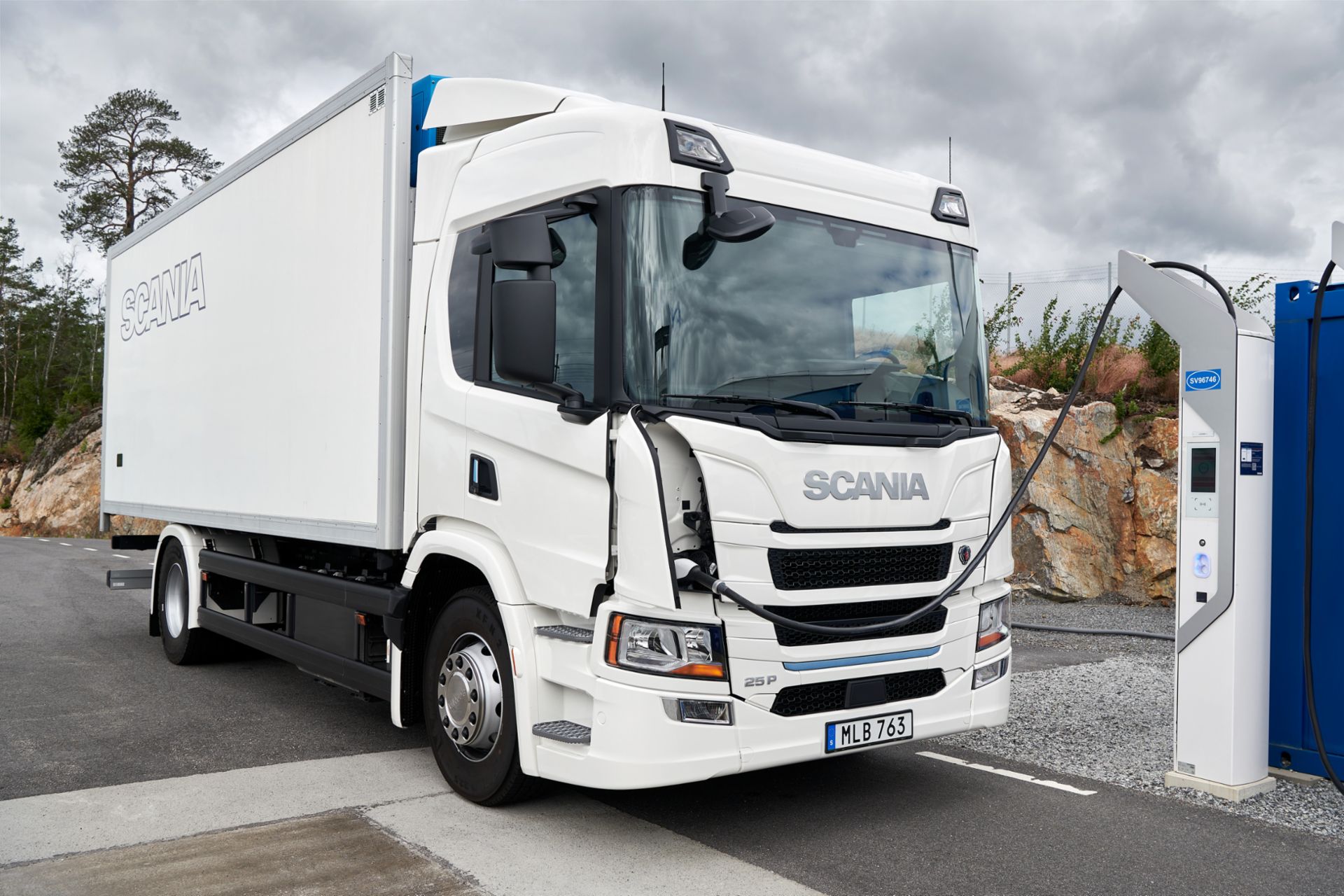TCS blog
Charging commercial vehicles is about much more than plugs and power – it’s about building the infrastructure, partnerships, and digital services that keep electric transport moving. In this blog, we share behind-the-scenes stories, industry insights, and expert perspectives that shape the future of public charging for heavy-duty vehicles across Europe.
Not one-size-fits-all: Rethinking EV charging for commercial vehicles

02.05.2025
As the adoption of electric vehicles (EVs) accelerates, the infrastructure supporting them must evolve to meet the distinct needs of both passenger cars and commercial vehicles. While there are overarching similarities in the goal of providing efficient charging solutions, the specific requirements of these two categories necessitate tailored approaches.
Charging power and vehicle requirements
Passenger cars typically feature battery capacities ranging from 80 to 120 kWh, offering driving ranges between 400 to 550 kilometers. Consequently, charging stations for these vehicles are designed to accommodate these specifications, often providing AC chargers with power outputs up to 22 kW, suitable for overnight charging at residences or workplaces. Public charging stations may offer DC fast chargers, delivering higher power levels (typically 50 to 350 kW) for quicker top-ups during the day.
In contrast, commercial vehicles – such as electric trucks and buses – are equipped with significantly larger battery packs to support demanding daily operations. This requires charging infrastructure capable of delivering much higher power to minimize downtime. Technologies like the Megawatt Charging System (MCS) are now being developed and piloted, with power levels reaching 750 – 1000 kW. This is key to enabling high-efficiency charging during short driver rest periods and maintaining operational continuity for logistics fleets.
B2C vs. B2B charging models
Charging for passenger cars typically operates on a Business-to-Consumer (B2C) basis. It’s geared toward individual EV owners who rely on a mix of home, workplace, and public charging options. Public chargers are often placed in urban centers, shopping malls, supermarkets, hotels, and increasingly along highways, where ultra-fast chargers (150 – 350 kW) are becoming more common to enable long-distance travel. The business model is straightforward: users pay per kWh, by time, or through app-based subscriptions, with minimal complexity and relatively short usage cycles.
The B2B charging ecosystem for commercial vehicles is fundamentally different – more complex, more strategic, and more operationally critical. Fleet operators depend on charging as an integrated part of their business model, and therefore require bespoke solutions that go beyond simply plugging in.
B2B charging relationships often involve long-term contracts with tailored service-level agreements (SLAs), negotiated pricing, and volume-based tariffs. These arrangements provide cost predictability over time, which is essential for fleet operators managing hundreds of vehicles and calculating total cost of ownership (TCO). In some cases, charging solutions are bundled with fleet management tools, offering live data on energy consumption, vehicle readiness, route planning, and load balancing across the fleet. Some operators also secure dedicated charging capacity at key hubs, with guarantees on uptime and 24/7 support, to ensure business continuity. In this context, the role of the charging provider shifts from a simple service vendor to a strategic partner in the fleet’s electrification journey.
We increasingly see that CPOs (charging point operators) are targeting themselves more specifically toward either B2C or B2B markets. Among those targeting both, many now begin to separate their networks, recognizing that these segments require entirely different infrastructure, economics, and customer service. While passenger cars can generate volume, B2B heavy-duty vehicle (HDV) charging allows for more revenue potential per session – though with greater upfront expectations and operational demands.
Infrastructure design and charging locations
The location and design of charging infrastructure are tailored to how each vehicle category is used. For passenger cars, charging must be as convenient and accessible as possible. Urban and residential areas dominate, but highways play an increasingly important role, especially for longer journeys. Here, ultra-fast chargers (150 – 350 kW) are crucial to minimizing downtime and replicating the refueling convenience of petrol stations. Charging operators and OEMs alike are working to ensure that highway corridors are well covered, enabling seamless long-distance travel across regions and countries.
Commercial vehicle charging infrastructure, on the other hand, is more complex. Charging hubs must be located strategically along major freight corridors, close to logistics centers, ports, and industrial zones, and increasingly also along highways to support en-route fast charging. However, trucks cannot simply pull into any car charging station. They require longer parking spaces, wider turning areas, and dedicated truck-accessible layouts. Power requirements are also significantly higher, often necessitating custom-built substations and advance coordination with grid operators.
From a B2B and HDV customer perspective, this separation is not only welcome – it’s necessary. Commercial vehicle drivers need to avoid sharp turns, low-clearance roofs, or narrow entrances that could impede vehicle movement. Just as important is the need to avoid queues or being blocked by smaller vehicles, such as taxis, especially in open-access stations without booking systems or designated lanes.
The inclusion of commercial charging at highway rest stops is emerging as a vital part of the puzzle, particularly to support regulatory rest times that align well with high-power charging needs. These sites are now being designed to mirror the fuel station experience, with food, restrooms, showers, and security – all critical for professional drivers.
Driver amenities and expectations
As the market matures, both passenger and commercial drivers expect more than just a plug. While EV drivers appreciate amenities like restrooms, Wi-Fi, or coffee shops, commercial drivers – often spending full working days on the road – require even more tailored services.
Modern truck charging hubs are beginning to offer rest facilities, showers, food services, and safe overnight parking. These amenities not only improve the experience for drivers but are also aligned with legal rest-time requirements in the transport sector. In this way, commercial charging hubs are evolving to resemble modern service areas, comparable to what we know from today’s fuel stations.
Similarities and shared goals
Despite these differences, there is common ground. Both types of networks aim for reliability, speed, and a positive user experience. Both benefit from interoperability, open standards, and consistent pricing structures. As the EV landscape evolves, we may see a partial convergence of features – such as shared charging platforms, driver apps, and cross-compatible payment systems – but the fundamental design and operation of the two network types will continue to reflect the needs of two very different user groups.
What’s also becoming increasingly clear is the growing importance of charging station quality and uptime. For B2B customers under commercial pressure, broken chargers or poor digital interfaces create significant operational risks. Studies show that passenger car charging stations can be faulty in up to 70% of cases, whether due to mislabelled geolocation, faulty RFID readers, or system downtime. B2B operators cannot afford this level of unpredictability. There’s more at stake financially, more dependencies on uptime, and therefore there is a need for greater incentives to build robust infrastructure and keep the quality on a high level.
From oil to electrons: Why big oil is investing in EV charging

02.05.2025
Seeing the growing e-trucks market, OilCo are investing in dedicated infrastructure. With high financial capabilities, secured strategic land and customer loyalty, they’re also restricting their network in favor of their own eMSP solutions. Therefore, access to their network at a competitive price is being conditioned to a volume commitment. Major player strategy proposed by TCS aims to identify those players and define a cap of GWh on our side to potentially use on negotiations, in close cooperation with brands – which, at the end, can provide those volumes.
In recent years, major oil companies such as BP, Shell, and TotalEnergies have been making significant investments in the electric vehicle (EV) charging sector. This strategic shift aims to adapt to the evolving energy landscape and secure their positions in a future where electromobility plays a central role.
Recognizing the global transition towards sustainable energy, these oil giants are leveraging their extensive resources to establish a foothold in the EV charging market. For instance, Shell has announced plans to install 50,000 EV charging stations worldwide by 2025, expanding its reach to meet the growing demand for electric mobility. Similarly, BP has invested heavily in increasing its EV charging infrastructure, aiming to grow its network from 7,500 to 70,000 charging points by 2030.
These companies are not only installing charging stations but are also acquiring existing EV charging networks and technology firms to enhance their capabilities. This approach allows them to integrate vertically within the EV charging value chain, offering comprehensive services to consumers and fleet operators.
The primary driver for this strategic pivot is the anticipated decline in oil demand due to the rise of EVs. Transportation accounts for a significant portion of global oil consumption, and as EV adoption increases, traditional fuel sales are expected to decrease. By investing in EV infrastructure, oil companies aim to offset potential losses and capitalize on new revenue streams.
Additionally, these investments align with broader corporate sustainability goals and the increasing regulatory pressures to reduce carbon emissions. By diversifying into the EV sector, oil companies can enhance their public image and meet evolving environmental standards.
However, recent developments indicate a nuanced approach. BP, for example, has announced plans to increase its investments in oil and gas to around $10 billion annually, aiming to boost oil production to 2.3 to 2.5 million barrels per day by 2030. Concurrently, BP intends to reduce its annual investments in renewable energies to $1.5 to $2 billion, focusing more selectively on energy transition projects.
This strategic adjustment comes after a significant profit decline in 2024 and pressure from investors, such as the US hedge fund Elliott Management, which has advocated for increased investments in traditional energy sources. This shift has drawn criticism from environmental groups, highlighting the tension between financial performance and commitments to sustainability.
For TRATON Charging Solutions, the entry of oil majors into the EV charging market necessitates strategic responses. To ensure competitive access to charging networks, TRATON Charging Solutions is focusing on establishing direct agreements with these Charging Point Operators (CPOs). This approach aims to secure favorable pricing and reliable access for customers, mitigating potential dependencies on networks controlled by oil companies.
In summary, while oil companies are investing in EV infrastructure to adapt to the changing energy landscape, their continued and even renewed focus on fossil fuels presents a complex dynamic. This dual approach reflects the challenges these companies face in balancing traditional revenue streams with the imperative to transition toward sustainable energy solutions.



